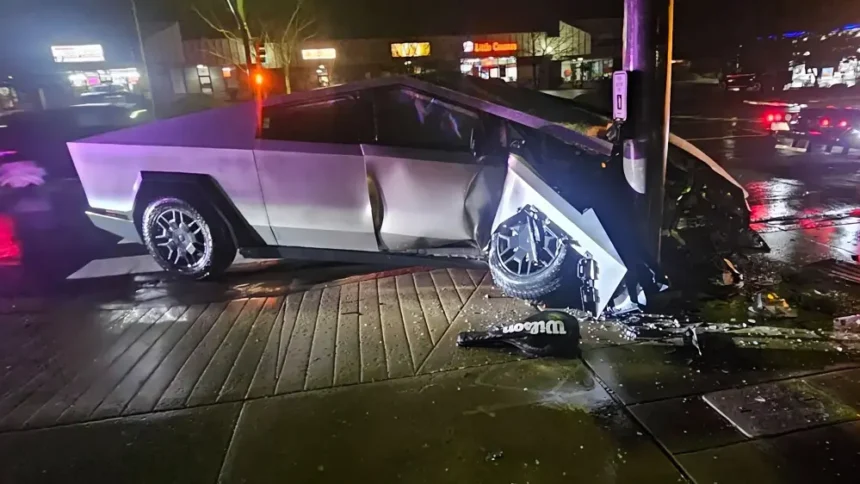On Feb. 9, 2025, near the end of the right lane in Florida, a Cybertruck crash happened when it did not merge in front of a clear neighboring lane. The car slammed into a curb before slamming into a light. But as Challinger was not hurt, he added that driver alertness using the autonomous functions was important, admitting he had a slip of concentration.
A Detailed Account of What Went Down
In the fateful case that occurred on February 9th, 2025, at 10:29am, specifically at Reno Nevada, a Cybertruck crash took place when a Tesla Cybertruck with Jonathan Challinger was being operated in Full Self Driving (FSD) mode.
The vehicle crashed into a lamppost upon not merging out of an ending lane as it should have, according to INFOComm line of sight. After stepping out unharmed, he admitted to his lapse in focus and reinforced how driver awareness remains just as important even if it is coupled with the use of self-driving technologies.
And he said that he appreciated Tesla’s safety engineering and ‘thank you @Tesla for creating the safest passive safety in the world.’ I scratched but didn’t omit at all. Challinger thought to himself that had the video been shot through the windshield before it began to spin out of control, he would have shared it on dashcam to teach people, but he stopped ‘because I didn’t want to feed its irritators.’
Exploring Its Impressive Safety Features
The Tesla Cybertruck’s design is meant to be safe for occupants and durable. Its strong outer shell is made from ultra-hard 30x cold-rolled stainless steel.
Crash forces get absorbed and spread through Cybertruck’s strategically built front and rear Giga Castings like crumple zones in conventional cars, therefore offering passive safety.
Despite the Cybertruck crash incident, the vehicle was found to be structurally stable for crash testing by the National Highway Traffic Safety Administration (NHTSA), and crash-tested 5 stars out of 5.

Its Capabilities and Limitations
However, Tesla’s Full Self-Driving (FSD) makes cars automate some driving chores, but the technology still requires constant human monitoring.
Overreliance may cause inattention due to studies that suggest drivers might not be as cautious while FSD is engaged.
Community and Media Reactions to the Incident
The recent Cybertruck crash while in Full Self Driving has spurred many conversations on social media. The car’s safety features were also praised by driver Jonathan Challinger, who is fighting for the life of Miller, but the design has been both celebrated and criticized by conflicting opinions, some praising Tesla’s design while others calling the dependability of Tesla’s autonomous technology into question.

How Did Tesla Respond? Official Statements Following the Crash
Tesla has not said anything formally. The FSD business, once more, underlines how active driver monitoring is always essential. The recalls came about out of concerns for safety, with Tesla starting December 2024 recalling models with 700,000 cars because of a malfunction on the tire pressure monitoring system. All of these steps are Tesla’s way of making sure they keep their vehicle safety improving and doing so early in the problem cycle.
Analyzing Crash Data from the Vehicle’s Systems
Key information from the Cybertruck crash incident showed that the Cybertruck hit the lamppost while not merging out of an ending lane. Under complex traffic conditions, analysts note FSD’s lane detecting and decision-making systems have possible problems. This indicates the need for ongoing human driver control since Tesla’s FSD is not entirely autonomous.
How Does the Cybertruck Compare?
With a 12.4 percent chance of rollover, the Tesla Cybertruck was rated four stars for rollover resistance. Otherwise, it exceeded in frontal and side impact testing and received a five-star overall safety rating by the National Highway Traffic Safety Administration (NHTSA). Rivian R1T was “Top Safety Pick +” by the Insurance Institute for Highway Safety (IIHS), therefore had a “Good” rating in most crash tests. While both vehicles handle safety well, the Cybertruck crash raises questions about its unique design, with its backward-opening doors called out for potential pedestrian safety and crumple zone efficacy.
What Happens After Autonomous Vehicle Incidents?
Legal questions become hard with relation to responsibility, especially with incidents involving autonomous cars. Faced with a lack of federal rules, a patchwork of state law has taken shape limiting how such events are handled, with inconsistencies from state to state. For example, 29 states have been voting on autonomous car legislation, and in 2018 there were 29 states that had some form of legislation related to these autonomous cars. These difficulties, however, are prompting regulatory agencies to up the ante, and the California Public Utilities Commission now requires that operators of autonomous cars extensively report incidents in order to increase their responsibility and safety.
The most recent Cybertruck crash event emphasizes the vital requirement of ongoing driver involvement even with sophisticated automated capabilities. Ensuring strong safety precautions and clear rules stays first as Tesla and regulatory agencies negotiate the changing terrain of self-driving technologies.



